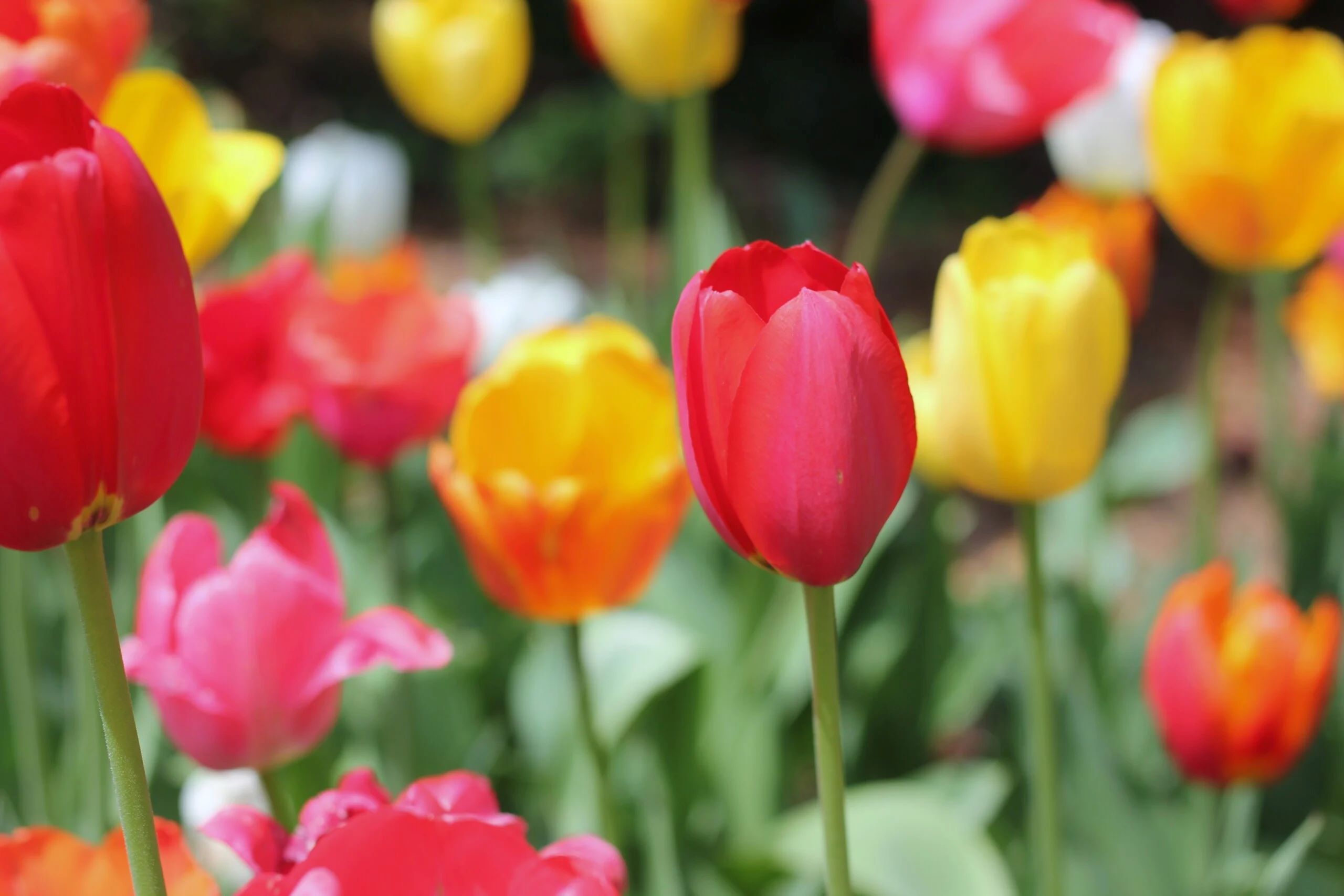Home>Home and Garden>Perennial Tulip Vs Regular Tulip: Understanding The Distinctions


Home and Garden
Perennial Tulip Vs Regular Tulip: Understanding The Distinctions
Published: February 19, 2024
Discover the differences between perennial tulips and regular tulips for your home and garden. Learn how to distinguish and care for each variety effectively.
(Many of the links in this article redirect to a specific reviewed product. Your purchase of these products through affiliate links helps to generate commission for Regretless.com, at no extra cost. Learn more)
Table of Contents
Introduction
Tulips, with their vibrant and captivating blooms, have long been cherished as a symbol of elegance and beauty in the world of gardening and landscaping. These beloved flowers come in various types, each with its own unique characteristics and growing requirements. Among the diverse tulip varieties, two popular categories stand out: perennial tulips and regular tulips. Understanding the distinctions between these two types is essential for garden enthusiasts and homeowners looking to add a touch of allure to their outdoor spaces.
In this comprehensive guide, we will delve into the differences between perennial tulips and regular tulips, shedding light on their individual traits, growing conditions, and uses in landscaping. By gaining insight into the unique features of each type, you will be better equipped to make informed decisions when selecting tulips for your garden. Whether you are a seasoned gardener or a novice enthusiast, this exploration will provide valuable knowledge to enhance your appreciation of these timeless and enchanting flowers.
History of Tulips
Tulips have a rich and fascinating history that traces back centuries, captivating the hearts of people across the globe. Originating from Central Asia and Turkey, these exquisite flowers made their way to Europe in the 16th century, igniting a craze known as "tulip mania." During this period, tulips became a symbol of wealth and prosperity, with their popularity reaching unprecedented heights.
The allure of tulips quickly spread throughout the continent, captivating the Dutch in particular. The Netherlands soon emerged as a hub for tulip cultivation, leading to the development of new varieties and the establishment of the iconic Dutch tulip industry. The Dutch Golden Age saw tulips being revered as a status symbol, with rare and uniquely colored bulbs commanding exorbitant prices.
Tulips also hold a special place in Turkish culture, where they have been cherished for centuries. In Turkey, the tulip serves as a symbol of abundance and indulgence, adorning various art forms and textiles as a testament to its cultural significance.
Over time, tulips have evolved from being a symbol of opulence to becoming a beloved and accessible flower for gardens and landscapes worldwide. Their enduring popularity is a testament to their timeless beauty and the emotional connections they foster.
Today, tulips continue to captivate enthusiasts and gardeners, with a diverse range of varieties available to suit different preferences and growing conditions. The history of tulips serves as a testament to their enduring appeal and the profound impact they have had on cultures and societies throughout the ages.
Characteristics of Perennial Tulips
Perennial tulips, also known as botanical tulips, are a captivating category within the tulip family, renowned for their enduring nature and distinctive features. These charming flowers are known for their ability to return year after year, adding a touch of elegance and color to gardens and landscapes. Here are the key characteristics that set perennial tulips apart:
-
Naturalizing Ability: Perennial tulips have a remarkable naturalizing ability, meaning they can thrive and multiply over time without requiring extensive maintenance. This naturalizing tendency allows them to create stunning displays, gradually spreading and enhancing the visual appeal of the surrounding area.
-
Variety of Species: Perennial tulips encompass a diverse array of species, each offering unique colors, shapes, and sizes. From the delicate Tulipa humilis to the striking Tulipa tarda, these varieties showcase an impressive range of characteristics, catering to different aesthetic preferences and garden designs.
-
Adaptability: These tulips exhibit exceptional adaptability to various growing conditions, making them suitable for a wide range of climates and soil types. Whether planted in rock gardens, borders, or containers, perennial tulips demonstrate resilience and versatility, thriving in different environments with minimal fuss.
-
Early Bloomers: Many perennial tulip species are early bloomers, heralding the arrival of spring with their vibrant blossoms. Their ability to flower early in the season adds a delightful burst of color to gardens, providing a refreshing sight after the winter months.
-
Longevity: Unlike their traditional counterparts, perennial tulips boast impressive longevity, with some species persisting for several years without the need for frequent replanting. This enduring quality makes them a valuable addition to garden landscapes, offering sustained beauty and charm over an extended period.
-
Natural Charm: With their graceful, naturalistic appearance, perennial tulips exude a charming allure that complements various garden styles, from formal layouts to more relaxed, cottage-inspired settings. Their effortless elegance and timeless appeal make them a favored choice for gardeners seeking enduring beauty.
In essence, perennial tulips stand out for their naturalizing ability, diverse species, adaptability, early blooming nature, longevity, and inherent charm. These distinctive characteristics make them a cherished and sought-after addition to gardens, enriching outdoor spaces with their enduring beauty and captivating presence.
Characteristics of Regular Tulips
Regular tulips, often referred to as Dutch tulips, are synonymous with classic beauty and timeless elegance. These iconic flowers have garnered widespread admiration for their enchanting blooms and versatile nature. Here are the key characteristics that distinguish regular tulips:
-
Diverse Varieties: Regular tulips encompass an extensive range of varieties, each boasting its own unique colors, shapes, and sizes. From the traditional single-flowered tulips to the flamboyant parrot tulips and the graceful lily-flowered tulips, this category offers a diverse palette of options to suit various aesthetic preferences and garden designs.
-
Seasonal Blooms: These tulips typically bloom in the spring, heralding the arrival of the season with their vibrant and captivating flowers. Their seasonal blooming pattern adds a delightful burst of color to gardens, creating a visually stunning display that captures the essence of springtime.
-
Bulb Renewal: Regular tulips are known for their reliable performance and the need for periodic bulb renewal. Unlike perennial tulips, which exhibit naturalizing tendencies, regular tulips benefit from being replanted or refreshed every few years to maintain their vigor and ensure consistent flowering.
-
Versatile Uses: Regular tulips are highly versatile and can be utilized in various landscaping applications, including borders, mass plantings, containers, and floral arrangements. Their adaptability makes them a popular choice for adding splashes of color to both formal and informal garden settings.
-
Classic Elegance: With their timeless appeal and classic beauty, regular tulips exude an air of sophistication that complements a wide range of garden styles. Whether adorning formal flower beds or enhancing the charm of cottage gardens, these tulips infuse outdoor spaces with an aura of elegance and grace.
-
Cultural Significance: Regular tulips hold cultural significance, particularly in Dutch heritage, where they have become an enduring symbol of beauty and abundance. The Netherlands' renowned tulip fields and annual tulip festivals celebrate the cultural and historical importance of these beloved flowers.
In summary, regular tulips stand out for their diverse varieties, seasonal blooms, periodic bulb renewal, versatile uses, classic elegance, and cultural significance. Their enduring popularity and timeless allure make them a beloved choice for gardeners and enthusiasts seeking to adorn their outdoor spaces with the captivating beauty of these iconic flowers.
Growing and Care Differences
When it comes to growing and caring for perennial tulips versus regular tulips, there are distinct differences that gardeners should consider to ensure the optimal health and longevity of these beloved flowers.
Perennial Tulips
Perennial tulips are known for their low-maintenance nature, making them an attractive choice for gardeners seeking enduring beauty with minimal effort. These tulips exhibit a remarkable naturalizing ability, meaning they can thrive and multiply over time without demanding extensive care. When planting perennial tulips, it is essential to choose a well-drained location with ample sunlight. These resilient flowers can adapt to various soil types, provided that the soil is not waterlogged, as excessive moisture can lead to bulb rot. Once planted, perennial tulips require little intervention, as they are adept at thriving on their own, gradually spreading and enhancing the visual appeal of the surrounding area. While they benefit from occasional watering during dry spells, they generally do not require intensive maintenance, making them an ideal choice for busy gardeners.
Regular Tulips
In contrast, regular tulips necessitate more attentive care and maintenance to ensure consistent flowering and vitality. These tulips typically require well-drained soil and ample sunlight, similar to perennial tulips. However, unlike their perennial counterparts, regular tulips benefit from periodic bulb renewal to maintain their vigor and ensure prolific blooms. After the flowering period, it is essential to allow the foliage to wither naturally, as this process allows the bulbs to store energy for the following season. Once the foliage has yellowed and dried, the bulbs can be lifted, divided if necessary, and replanted at the appropriate depth for the next growing cycle. Additionally, regular tulips may benefit from a balanced fertilizer application in the early spring to support healthy growth and vibrant blooms.
By understanding the distinct growing and care requirements of perennial tulips and regular tulips, gardeners can make informed decisions and provide the necessary attention to ensure the enduring beauty and vitality of these cherished flowers in their outdoor spaces.
Bloom Time and Lifespan
The bloom time and lifespan of tulips play a pivotal role in shaping the visual impact and enduring allure of these beloved flowers. Understanding the distinct bloom periods and lifespans of perennial tulips and regular tulips is essential for gardeners seeking to create captivating displays and plan for the long-term vibrancy of their outdoor spaces.
Perennial Tulips
Perennial tulips are renowned for their early bloom time, often heralding the arrival of spring with their vibrant and enchanting flowers. These resilient blooms emerge in the early to mid-spring, injecting a burst of color into garden landscapes and signaling the awakening of nature after the winter slumber. The early bloom time of perennial tulips allows them to take center stage in the seasonal transition, captivating onlookers with their radiant hues and delicate petals.
In terms of lifespan, perennial tulips exhibit impressive longevity compared to their traditional counterparts. These enduring flowers can persist for several years, gracing gardens with their beauty and charm without the need for frequent replanting. Their ability to return year after year adds a sense of continuity and reliability to garden landscapes, creating a lasting impact that evolves and matures with each passing season.
Regular Tulips
Regular tulips, known for their seasonal blooms, typically flower in the spring, aligning with the traditional symbolism of renewal and rejuvenation associated with this time of year. Their bloom time coincides with the awakening of nature, as they unfurl their captivating blossoms to adorn gardens with a kaleidoscope of colors. The seasonal bloom of regular tulips marks a fleeting yet enchanting period, where their vibrant display adds a touch of splendor to outdoor spaces.
In terms of lifespan, regular tulips benefit from periodic bulb renewal to maintain their vigor and ensure consistent flowering. While they may not exhibit the same enduring nature as perennial tulips, regular tulips can thrive for multiple seasons with proper care and attention. By refreshing the bulbs and providing the necessary maintenance, gardeners can prolong the lifespan of regular tulips, allowing them to continue gracing gardens with their timeless beauty.
By recognizing the distinct bloom times and lifespans of perennial tulips and regular tulips, gardeners can strategically plan and cultivate captivating displays that evolve and thrive over time. Whether seeking the enduring charm of perennial tulips or the seasonal splendor of regular tulips, these distinct bloom periods and lifespans contribute to the dynamic tapestry of nature's beauty in garden landscapes.
Uses in Landscaping
The versatile nature of tulips makes them invaluable assets in landscaping, offering a myriad of creative possibilities to enhance outdoor spaces. Whether adorning formal gardens, accentuating borders, or enlivening naturalistic settings, both perennial tulips and regular tulips contribute to the visual splendor of landscapes in distinctive ways.
Perennial Tulips
Perennial tulips, with their naturalizing ability and enduring charm, are well-suited for various landscaping applications. Their resilience and adaptability make them ideal candidates for naturalizing in meadows, woodlands, and rock gardens, where they can thrive and multiply, creating captivating displays that evolve over time. These tulips also excel in mixed borders, adding a touch of elegance and color to perennial plantings. Their early bloom time makes them valuable assets for heralding the arrival of spring, infusing landscapes with a sense of renewal and vitality. Additionally, perennial tulips can be utilized in container gardens, where their enduring beauty can be showcased on patios, balconies, and other outdoor living spaces.
Regular Tulips
Regular tulips, with their diverse varieties and classic elegance, offer a wealth of possibilities in landscaping design. Their seasonal blooms make them ideal for creating striking focal points in formal garden beds, where their vibrant colors and graceful forms can command attention and add a sense of refinement. Mass plantings of regular tulips can transform open spaces into captivating tapestries of color, making them ideal for public gardens, parks, and commercial landscapes. These tulips also lend themselves well to floral arrangements, serving as exquisite cut flowers that bring the beauty of the outdoors into interior spaces.
In both cases, the uses of tulips in landscaping extend beyond their visual appeal. Their symbolic significance and cultural associations add depth and meaning to outdoor environments, evoking emotions and memories that enrich the overall experience of the landscape.
By leveraging the unique characteristics of perennial tulips and regular tulips, landscapers and gardeners can craft captivating outdoor scenes that evolve with the seasons, creating enduring beauty and enchantment in the natural world.
Conclusion
In conclusion, the distinctions between perennial tulips and regular tulips offer valuable insights for gardeners and enthusiasts seeking to elevate their outdoor spaces with the timeless allure of these beloved flowers. Perennial tulips, with their naturalizing ability, diverse species, adaptability, and enduring charm, stand out as resilient and low-maintenance additions to gardens and landscapes. Their early bloom time and impressive longevity make them valuable assets for heralding the arrival of spring and infusing outdoor spaces with sustained beauty.
On the other hand, regular tulips, with their diverse varieties, seasonal blooms, classic elegance, and cultural significance, bring a sense of refinement and versatility to landscaping designs. Their vibrant displays and symbolic importance contribute to the visual splendor of gardens, creating captivating focal points and mass plantings that evoke the spirit of renewal and abundance.
By understanding the distinct characteristics, growing requirements, bloom times, and uses of perennial tulips and regular tulips, gardeners can make informed decisions to curate captivating displays that evolve and thrive over time. Whether seeking the enduring charm of perennial tulips or the seasonal splendor of regular tulips, both categories offer unique opportunities to infuse outdoor spaces with the captivating beauty of these iconic flowers.
Ultimately, the enduring appeal of tulips transcends their visual splendor, encompassing cultural significance, historical resonance, and emotional connections that enrich the tapestry of nature in garden landscapes. As gardeners and enthusiasts continue to cultivate and appreciate the timeless allure of tulips, these cherished flowers will continue to inspire and captivate, creating enduring beauty and enchantment in the natural world.












